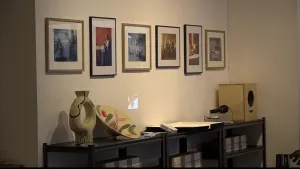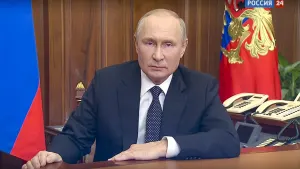More Stories
Russia widened its offensive in Ukraine on Friday, striking airfields in the west and a major industrial city in the east, while the huge armored column that had been stalled for over a week outside Kyiv was on the move again, spreading out into forests and towns near the capital.
On the economic and political front, the U.S. and its allies moved to further isolate and sanction Russia by revoking its most favored trading status, while on the ground, the Kremlin's forces appeared to be trying to regroup and regain momentum after encountering heavier losses and stiffer resistance than anticipated.
“It’s ugly already, but it’s going to get worse,” said Nick Reynolds, a land warfare analyst at Royal United Services Institute, a British think tank.
With the invasion in its 16th day, Russian President Vladimir Putin said there had been “certain positive developments” in Russia-Ukraine talks, but gave no details.
For his part, Ukrainian President Volodymyr Zelenskyy said Ukrainian forces had “reached a strategic turning point," though he did not elaborate.
“It’s impossible to say how many days we will still need to free our land, but it is possible to say that we will do it," he said via video from Kyiv.
He also said authorities were working on establishing 12 humanitarian corridors and trying to ensure food, medicine and other basics get to people across the country. Thousands of civilians and soldiers on both sides are believed to have been killed in the invasion.
So far, the Russians have made the biggest advances on cities in the east and south - including in Mariupol, the heavily bombarded seaport where civilians scrounged for food and fuel amid a harrowing 10-day-old siege - while struggling in the north and around Kyiv.
On Friday, they continued to launch airstrikes in urban areas such as Kyiv, Kharkiv and Mariupol, while also pounding targets away from the main battle zones.
Russian Defense Ministry spokesman Igor Konashenkov said Russia used high-precision long-range weapons to put military airfields in Lutsk and Ivano-Frankivsk in the west “out of action.”
The Lutsk strikes killed four Ukrainian servicemen and wounded six, Lutsk Mayor Ihor Polishchuk said. In Ivano-Frankivsk, residents were ordered into shelters in an air raid alert
Russian airstrikes also targeted for the first time the eastern city of Dnipro, a major industrial hub and Ukraine’s fourth-largest city, situated on the Dnieper River. Three strikes hit, killing at least one person, according to Ukrainian Interior Ministry adviser Anton Heraschenko.
In images of the aftermath released by Ukraine’s emergency agency, firefighters doused a flaming building, and ash fell on bloodied rubble. Smoke billowed over shattered concrete where buildings once stood.
In another potentially ominous development, new satellite photos appeared to show the massive Russian convoy outside the Ukrainian capital had split up and fanned out.
Howitzers were towed into position to open fire, and armored units were seen in towns near the Antonov Airport north of the city, according to Maxar Technologies, the company that produced the images.
The 40-mile (64-kilometer) line of tanks and other vehicles had massed outside Kyiv early last week. But its advance had appeared to stall amid reports of food and fuel shortages, muddy roads and attacks by Ukrainian troops with anti-tank missiles.
The purpose of the latest move was unclear, though Russia is widely expected eventually to try to encircle the capital.
Britain's Ministry of Defense said that after making “limited progress,” Russian forces were trying to “re-set and re-posture” their troops, gearing up for operations against Kyiv.
But Reynolds, the defense analyst, said the move, in part, looked like an attempt by the troops to better protect themselves by dispersing. He said it may indicate the Russians are not ready to surround the city just yet.
Repeated rounds of negotiations between Russia and Ukraine have taken place along the Belarus border, and the two countries' foreign ministers held talks on Thursday with no apparent progress, while various third countries have also made attempts to broker a stop to the fighting.
A Western official, speaking on condition of anonymity to discuss intelligence matters, said the fact that negotiations are taking place so early in the fighting “might speak to Russian concerns” about the progress of the war.
On Wednesday, Ukrainian soldiers traversed snow-dusted fields and woods near Kyiv, rifles and rocket-propelled grenade launchers slung over their shoulders, in a video recorded by Radio Free Europe. One of them vowed to kill their enemies over the bombing of Mariupol.
Gunfire and explosions could be heard, and at one point, shots split the air nearby, and the soldiers dropped to the ground and returned fire.
In Washington, President Joe Biden announced the U.S. will dramatically downgrade its trade status with Russia as punishment for its invasion and also ban imports of Russian seafood, alcohol and diamonds. The move to revoke to revoke "most favored nation” status for Russia was taken in coordination with the European Union and Group of Seven countries.
“The free world is coming together to confront Putin,” Biden said.
Stripping most favored nation status from Russia would allow the U.S. and allies to impose higher tariffs on some Russian imports. Other Western sanctions have already dealt a severe blow to Russia, causing the ruble to plunge, foreign businesses to flee and prices to rise sharply. Putin has insisted Russia can endure sanctions.
The United Nations' political chief said the U.N. has received credible reports that Russian forces are using cluster bombs in Ukraine, including in populated areas. Cluster bombs scatter “bomblets” over wide areas. Their use against civilians is prohibited under international law.
In Syria, Russia backed the government in imposing long, brutal sieges of opposition-held cities, wreaking heavy destruction and causing widespread civilian casualties. That history, along with the siege of Mariupol, has raised fears of similar bloodshed in Ukraine.
Temperatures sank below freezing across most of Ukraine and were forecast to hit -13 degrees Celsius (8 Fahrenheit) in the eastern city of Kharkiv, which has come under heavy bombardment.
About 400 apartment buildings in Kharkiv lost heat, and Mayor Ihor Terekhov appealed to remaining residents to descend into the subway or other underground shelters where blankets and hot food were being distributed.
The bombardment continued in Mariupol, where a deadly strike on a maternity hospital this week sparked international outrage and war-crime allegations. Repeated attempts to send in food and medicine and evacuate civilians from the city of 430,000 have been thwarted by continued attacks, and Ukrainian Deputy Prime Minister Iryna Vereshchuk put the number of dead there at more than 1,300.
Some 2.5 million people have fled Ukraine since the invasion began, according to the United Nations.
More from News 12
1:37

Election of Donald Trump stokes both hope and concern among Brooklyn's Ukrainian community
2:11

Ukrainian artists' Brooklyn exhibit tell the story of their war-torn country

Zelenskyy thanks 'every American,' sees 'turning point'

President Biden pledges $2.9B in food security aid amid Ukraine war

Putin sets partial military call-up, won’t ‘bluff’ on nukes
1:04
